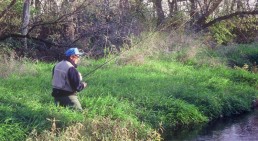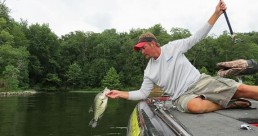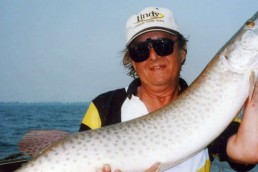Summer’s Often Overlooked Fishing Holes
SHARE THIS POST
It is easy to overlook some of summer’s best fishing. We spend so much of our fishing attention on lakes, reservoirs and rivers while overlooking those ponds so close to home. These are not only in the country, but many towns and cities have ponds, small lakes and water retention ponds.
The countryside is dotted with ponds ranging from less than an acre to those several hundred acres. They are often tailor-made for curing your ‘fishing fix’ during the week. There are usually more fish per acre in ponds than in a larger lake or reservoir. Ponds that receive light fishing pressure can be productive if one adapts his approach.
When fishing ponds you may run across bluegills, sunfish, catfish or bass. Some pond owners also add crappies, usually appropriated from some nearby large body of water. If managed well, pond fish do quite well.
Good fishery management includes fertilization and harvest control. Fertilization adds to the nutrient base and controls undesirable vegetation in much the same way a farmer tends his fields.
Most ponds experience algae problems during the warmer months. Two species in particular can be harmful—filamentous algae and blue-green algae.
Filamentous is a stringy type of vegetation. The blue-green algae forms light green, frothy mats on the surface. It is best to destroy these algae before adding the fertilizer. Unfortunately many landowners do not want to take the time or invest the money in their ponds. They still can be good fishing holes however may be frustrating to the angler whose lure tangles in the vegetation.
Fish kills also occur from time to time on small ponds. If just a few fish or one species of fish dies then it is probably a disease that is killing them. However if fish of several species die overnight it is most likely a chemical problem. Chemical problems can be low oxygen, insecticide or herbicide contamination.
Assuming the pond you have found contains healthy fish, there are still other considerations. Fishing a pond can be as challenging as fishing larger bodies of water, just different.
Ponds are the angler’s version of shooting fish in a barrel. He still needs to apply sound fishing knowledge of seasonal patterns, activity and location of specific species. Bass in a pond follow the same daily movement patterns as fish anywhere. Channel catfish tend to school and move around the pond on regular intervals. Anglers have to move with them.
Are you enjoying this post?
You can be among the first to get the latest info on where to go, what to use and how to use it!
Pond anglers need to use smaller baits and wear clothing that protects them from insects and plants found around a pond. Be quiet when walking and casting. Cast parallel to the bank rather than out to the middle of the pond. If there is an aerator in the middle, chances are the fish will migrate toward the highly-oxygenated water.
If using a float (bobber), the smaller the better. The relatively shallow water demands one not make a big splash during casting. A small float does not produce a large overhead image to frighten fish.
On cool days, bass feed below the surface and usually take underwater lures and baits presented slowly. As the water warms they strike surface lures near the shoreline early in the morning or late in the evening.
During daylight, fish migrate to location near stumps, fallen trees and points jutting out from shore.
If live bait is preferred, then minnows, crayfish, frogs and nightcrawlers are the ticket. Hook sizes of 1/0 to 6/0 are usual choices.
Bluegills and sunfish are vulnerable as they take to the spawning beds or along weedbeds near submerged brush. The simple cane pole combined with a small float and number 8 to 12 hook baited with earthworms, crickets, catalpa worms, leeches or maggots is a popular choice. Jiggle the bait up and down off the bottom. Sometimes you can leave it motionless on the bottom.
Catfish shun the light and feed near the bottom. Most of their feeding is in low light or at night. The pole and line method described above works with a number 2 or 4 circle hook. Bait is usually pieces of fish, crayfish, blood bait, chicken or turkey livers, cheese or stink baits.
Don Gasaway is a veteran outdoor writer from Marion, Ill. He may be contacted at: dongasaway.wordpress.com or facebook.com/DonsJournal.
MWO
SHARE THIS POST
Did you enjoy this post?
You can be among the first to get the latest info on where to go, what to use and how to use it!
Don Gasaway
Don Gasaway is a veteran freelance outdoor writer from Marion, Ill. He may also be found at: https://www.facebook.com/DonGasawayWriter and facebook.com/Wandering Angler. Comments are welcome




